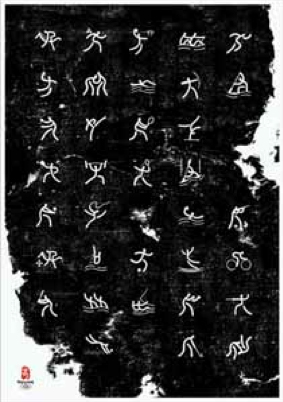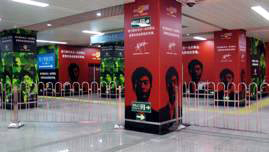Catherine Jo Ishino

Min Wang, 2008 Beijing Olympic events poster
Until recently, a positive view on the state of modern Chinese graphic design was difficult to find in the Western trade press. Hong Kong, under the rule of the British Empire up until 1997, was seen as simply mimicking and copying Euro-American works. The Mainland’s designs, under the Communist regime and economy since the 1950s, were dismissed as solely propagandistic and emulating the former Soviet Union’s visual mannerisms. It is as the New China, with its new market economy and powerful global presence, that Western design professions have begun to take notice that they have powerful design competition to face. Yet the Euro-American typecasting of Chinese design still lingers on, as evidenced in London’s current Victoria and Albert Museum exhibition, called China Design Now.1
First, the notion China’s effort to modernize its visual and cultural language by westernizing its graphic design is becoming less true and visibly so. In fact, the Western Darwinian notion of progress is a hierarchical, linear and individualistic one, which stands in opposition to the Eastern one, which is more communal, cyclical, and dialectical. In other words, the West sees the East as not progressing up the design ladder, rather replicating it. Whereas the East sees their modernization as a cyclical process, not a move up or down. Second, the conviction modern design is a Western import to China is historically unfounded. Asia is steeped in an ancient tradition of incorporating arts and crafts intertwined with its everyday living. In actuality, there is no equivalent of the word, or separated Western specialization such as ‘design’, in its vocabulary. Third, the myth, Chinese designers are simply copying Euro-American design, is yet another misreading by Western society, for there exists an age-old practice of apprentices emulating their masters’ works to learn new skills. This replication method in the East is a venerated educational and learning process.
In this article, I will not explore how the Internet has impacted the New China’s graphic design, and as I believe it is too early to get a solid reading on how it is functioning as of yet. Right now, the Internet remains an area of entrepreneurship in the new free market economy, which is still highly controlled by the Central Government throughout China. However, I do realize the significance of Web-based dissemination and access will become crucial in the future role of graphic design in China’s new market economy. In 2005, after a visit to China, established design journalist Rick Poynor posted his view that:
If there is cause for hope … a new form of public space …from a Chinese point of view… Large quantities of information [from the West] are now able to break through the traditional system of information control … The Internet gives the Chinese an anonymous platform for opinions that cannot otherwise be expressed freely … Digital images … are helping to create a new, more democratic order in Chinese society.2
Therefore, for the purposes of this paper, I will focus on printed work created since the Peoples Republic of China (PRC) began its Open Door Policy in 1979 and whose visual communication’s aim was to reach a bicultural audience of both West and East.
More specially, I set out to debunk three design falsehoods I see preventing outside professionals from seeing the recent graphic design being created in the New China without Western misinterpretations. They are: 1) Modernization Does Not Necessarily Equal Westernization, 2) Modern Graphic Design is a Western Import to the New China, and 3) Imitating is More than the Best Form of Flattery. By dispelling these stereotypes, I hope to reveal how the Chinese designers’ entry into the world market is giving them a new sense of global citizenry, as well as local identity. Their visual voices are being heard in the larger globalization narrative and, thus I believe, are enriching graphic design worldwide.
MYTH 1: Modernization Does Not Necessarily Equal Westernization
From the 1980s through the 1990s, in the early days of the New China’s free market economy, American trade journals reporting on graphic design being produced out of China portrayed the country’s works as largely being imitative of Western designs. On the generous side, some of the press attributed this copying to the lightning speed in which their visual communications industry was being forced to modernize. This pressure for China to catch up, after being in a 40-year state of isolation from capitalistic enterprises, was enormous. Beyond this factor, Euro-American corporations had brought in their own creatives to oversee the local designers. Once the locals were hired, they did not have the luxury of time to innovate their own design work. It was enough to deal with learning the new technologies, trying to sort out the imported visual language, and meet the foreigners’ tight deadlines. The entrepreneurs’ goal, in hiring these New Chinese designers, was to make the most work, at the lowest cost, and in the quickest amount of time. Then these venture capitalists could export the goods and sell them, at a higher profit margin, to their bargain-hunting consumers back in the West. Replicating, rather than recreating, clearly was the most cost efficient in this profit-making dynamic. Thus, the New Chinese designers were given the task of replicating what they had been trained to produce most efficiently.3 Design writer and educator, Clive Dilnot, In his 2003 DesignIssues article, Which Way Will the Dragon Turn?, summarizes this Western perspective on the New Chinese design:
‘R&D’ means not research and development but replication and duplication.
The negative implications for design epitomized by this model are obvious—the copy economy always will tend to trivialize, cheapen and operationalize the role of the designer. But is this situation all bad? Certainly it indicates the objective, structural, difficulty of establishing a mature design profession in China today, if by mature profession we think of something on the model of American or western European practice. But is this really what is required? Is there perhaps within the emerging situation, especially in the longer term, the seedbed of a different model of design altogether?

Earl Grey tea as marketed to Europeans in China
Dilnot goes on to point out different ways in which the Chinese design and designers could turn their situation in another direction.4 Of primary importance, he argues, “if the country were to move from being a ‘low-cost manufacturing unit’ to being the ‘global center of new product innovation’ this act would be the most transformative and empowering.”

Earl Grey tea as marketed to Chinese
Adding to this turn in a new designing direction, Min Wang, the present Dean of the Design School at the Central Academy of Fine Arts and design director of the 2008 Beijing Olympics, advocates:5
Our modernization path should be characterized by synthesis, innovation and sustainable development… We should find our own way based on our own culture and tradition … We need to proactively retain and promote our heritage and be cautious against indiscriminately copying western design theories or design languages.
You may see in his recent design of the Olympic events, Min Wang, true to his word, synthesized the modern and the traditional (Figure 1). Innovating from the original and widespread usage of the logo itself, Min Wang, innovates a grand metaphor. According to Ellen Shapiro’s May-June CA article, “…two millennia ago the Chinese began carving inscriptions into stone. In the seventh century they… [made] multiple copies of the records by covering the stones with paper and tamping the paper with an inked pad, the process [produced] white characters on a black background.” And you see in its lower-left hand corner of the ‘Official poster of the XXIX Olympiad’ , he symbolically uses the 2008 Beijing Olympic logo as the red signature seal; a ‘chop’ dipped in red ink, and pressed down as a ‘signature’ on an official document.
A design writer from India, Rajeshwari Ghose, in her 1989 article Design, Development, Culture, and Cultural Legacies in Asia states the case for Asian designers’ conflicted sense of agency from a post-colonial perspective:
Much of the polemics concerning design… in Asia is centered on this inherent tension between the local and the global, both in the material and cultural sense. At one end of the design spectrum are those who believe …Asian countries can and will achieve First World standards of living if only the right technological mix … right degree of patience … necessary amount of time … for the trickle-down effect …can be achieved.
Even more poignantly, Ghose points out:
… neither of the terms design nor development have natural equivalents in most … Asian linguistic traditions… they carry with them all the ideological underpinnings of First World associations, aspirations, and debates …the deep dissatisfaction that has followed this realization… from an ideological/cultural as well as a pragmatic point of view, has led to … soul searching among thinking designers of Asia in recent years.
 Beijing subway advertising
Beijing subway advertising
In agreement with Ghose, Chinese visual culturalist, Wendy Wong, asserts in her paper (2005),6 “The term ‘design’ does not have a natural equivalent or directly translatable term in most Asian languages …and the Chinese equivalent … in English is still unresolved after almost a century of development …even in today’s PRC education system, the Central Government adopted …Design Arts in English as an official title of programs in design.” Thus Wong maintains “studies from the cultural designing process aspects on Chinese design are seriously under developed.” This last statement on New China’s graphic design is troubling. Wong, an ardent exponent of the country’s design enterprises, is prodigious in her scholarly output 7 – publishing, speaking and curating- broadly and deeply, since she received her PhD in Design at the Hong Kong Polytechnic in 1999. She, herself, seems discouraged about the state of knowledge and scholarship of Chinese graphic design.
MYTH 2: Modern Graphic Design is a Western Import to the New China
… the close relation between the changing forms and styles of graphic design in China and the cultural and political forces with which Chinese designers have had to contend [is affirmed] by Scott Minick and Jiao Ping’s “Chinese Graphic Design in the 20th Century” -Victor Margolin, 1990
In his review of this classic text8, America’s first PhD design historian, Victor Margolin, summarizes this seminal book with acumen. He culls from his reading how Chinese differ from Western designers in adopting new design styles. Margolin writes, in the West ‘new-ness’ bases its continuum of change as “representations of the dominant ideology of cultural modernity.” However this form of modernism, he reveals, in China is seen as extreme and outside their own culture, where tradition and history are revered as well as followed for centuries. In Minick and Ping’s book, Margolin reviews how they trace indigenous design back to the first century A.D., when the Chinese invented papermaking. Furthermore, Margolin notes not until the 12th century was the West even capable of re-creating this technology. Given Chinese wood block printing began in 868 A.D. and moveable type was used between 1041-1048, China historically begins designing 400 years ahead of Gutenberg and his famed bible, which was first printed circa 1439. In fact, the first Chinese printed books to be discovered dated from 636 A.D. In short, the practice of design is not a recent Western import to China, rather a long-standing historic practice.
MYTH 3: Imitating is More than the Best Form of Flattery
Alongside ongoing design technology advancements taking place in China, the high art of traditional calligraphy, delivered via brush dipped in black ink, consistently developed highly refined design sensibilities as well. Being an apprentice and copying the masters’ works was the way of studying in this creative endeavor. In fact, it was the primary way of learning until an apprenticing calligrapher was able or capable of making a breakthrough. He could only be deemed a master when his own unique spirit expressed itself in his work. Thus Imitating a great master’s style and work is a long-standing learning tradition, not only in the art of calligraphy, but in many other artistic endeavors as well such as the performing arts, architecture, etc.
 Wine marketed to both Chinese and Westerners
Wine marketed to both Chinese and Westerners
Thus in his review of Minnick and Ping’s Chinese Graphic Design in the 20th Century, Margolin advocates that given deep historical artistic traditions continually being refined during the centuries, one could understand why the Chinese still prefer to continually improve or innovate, rather than break away to create new visual languages as is the historical practice in the West. Indeed these Easterners, Margolin reiterates, choose to develop gradually, rather than trying to make a drastic break from their art historical traditions. This stance is repeated over and over again in Chinese graphic design history, even in the face of aggressive Western industrial, economic and visual revolutions pushing the design enterprise to drastically change.9
Robert L. Peters’ 2004 article,
corroborates what Margolin writes. He quotes a high-ranking Chinese official he had interviewed while touring China:
…the issue of copying and the rights of the creator is viewed differently in China (and other Asian countries) than in the West. It’s the difference between sharing and hoarding, or between collective rights and the rights of the individual. The need to constantly create anew is viewed by many as wasteful and selfish… This variance in philosophical premise lies behind the reason. And so Peters concludes: Perhaps one can understand why the notion of copyright can be viewed as a dissonant notion in China, because of this long-shared Cultural notion.11
Beyond this traditional Chinese stance of innovation, the Eastern view of history is a circular one, not a linearly progressive positioning as in the Western World. Life is seen more in an intuitive, circular, Taoist and Confucist perspective in China, not like the Western view of a rational, linear, Christian and perhaps Calvinistic one. Or as the Chinese historian and writer, Wang Zheng stated:
The ancient Chinese history theories interpret history as cyclical while, from a modern viewpoint, history is a linear process evolving from primitive to advanced stages. The evolutionary theory is based on Social Darwinism, and makes Europe the center and development parameter to define cultural distinctions: some are deemed superior and others inferior.12
Indeed the current Chinese aim, as pointed out by design historian, Wendy Wong,13 is to begin to create a cohesive graphic design history of the New China under its new free market economy. Wong calls for designers to see the reunited country’s design developments as inter-related, rather than separate entities. This is highly pertinent, given Mainland China has reunited with its former territories of not only Hong Kong (1997), but Macao (1999)14 as well. Counter to these out-dated mythologies, Wong (2005) points out in her crucial paper “Detachment and Unification”:
Although Hong Kong has been a British colony from the period 1841 to 1997, its culture has always been rooted within Chinese tradition. The design direction that developed in Hong Kong after WWII evidenced little disjuncture with the Mainland China in the understanding of the heritage of the gongyi [art and craft] traditions.
One can begin to see the inter-related sensibility more with graphic design exchanges that take place throughout the 1990s. Taiwan first extended an invitation to Hong Kong designers in 1982 to come and show their works. What later comes to be called in 1991 Thematic Poster Invitational Exhibitions become critical in promoting interchange and an awareness of what had been going on in the previously separated and isolated regions of Macao, Taiwan, Hong Kong and Beijing. These shows are sponsored by major host cities throughout China that have established their own design associations. Each invited designer is asked to give their own individual interpretation of a chosen theme with Chinese characters, for instance – Communication, Good Luck, Harmony, Interaction, etc. The creative freedom unleashed in these invitationals15 occurs because there is no client, allowing the designers to more fully express their own visual voice without any outside constraints. These invitationals enable visual cross-fertilization to take place very quickly in the region, especially in previously separated and independent areas of design in Macau, Taiwan, Hong Kong, and Beijing.
In closing, I have argued against Western design myths surrounding the New China’s graphic design. Also, when I visited Beijing last year for nine weeks, I had numerous discussions with graphic designers and visited their studios as well. It is my belief their professional goal entails combining their own cultural visual language with what they perceive as contemporary. This has already begun to coalesce in their everyday lives.
Notes
1 The Times of London, writing on the China Design Now show, summarizes: “…unveiling the material magnificence of another [besides Japan] long-isolated, mysterious, oriental civilisation, but one which is now suddenly ubiquitous …What is dispiriting is not just that China’s entire design output seems solely defined by rabid capitalism. It is how familiar are the products of this mysterious, oriental civilisation.”
2 R. Poynor, Design Observer, 05.05.05. The site and show that Poyner writes about now has a warning attached to its link, stating, “This site may harm your computer.” An example of how the Chinese government closely watches over the Web.
3 For more information see: Wang, Shou Zhi, (1989). Chinese Modern Design: A Retrospective. Design Issues, Vol. 6, No. 1, Design in Asia and Australia. (Autumn, 1989), pp. 66-68.
4 He had taught for a number of years at the Hong Kong Polytechnic University.
5 From p. 91, Official poster of the XXIX Olympiad, Communication Arts, Vol. 360. May/June 2008. Or Vol 50, Number 2 at www.commarts.com
6 Design Identity of Hong Kong: Colonization, De-colonization, and Re-colonization. NOTE: This paper has been published numerous places- on the author’s own website, as a paper read at The 6th International Conference of the European Academy of Design, University of the Arts, Bremen, Germany (2005), and in Design Issues.
7 As a Hong Kong national, she attained her PhD at the Polytechnic University during Clive Dilnot’s time there. Since 2001, she has published four substantive, peer-reviewed articles on the subject in MITs DesignIssues journal as well as 29 others, curated two major design shows- one at the Cooper-Union Art and Design School in New York City, and most recently at the Design X-Change in Toronto, as well as eight others , and given over a dozen papers on the topic.
8 Design Issues, Vol. 8, No. 2. (Spring, 1992), pp. 82-84.
9 Ibid.
10 Perhaps this is in response to Dilnot’s earlier one of 1989, entitled Which Way Will the Dragon Turn?
11 Peters, Robert L. (2004). No Sleeping Dragon. Communication Arts magazine, March/April 2004, pp. 86-99.
12 From Min Wang’s self-published book, Square Two World, Square Two Design: TWO WORLD DESIGN, (no publication date @ 2001), p. 13
13 Wong, Wendy S., (2001). Detachment and Unification: A Chinese graphic design history in Greater China since 1979. Design Issues, Vol. 17(4), p. 51-71. Autumn 2001.
14 Occupied by Portugal until 1999.
15 Derived from the European and Japanese designers.
Catherine Jo Ishino is pursuing a graduate degree in Communication and Culture at Ryerson University in Toronto. She was a tenured professor at the University of Minnesota (1998-2007). Earlier Ishino worked in the TV news industry (1981-1994).











October 8, 2009 at 12:45 pm
Great article. I personally believe that the beauty of design lies within its transferability throughout culture and time. Since cave drawings, we’ve shared our idealisms and information with base simplicity so as to convey thought or persuasion to as vast an audience as possible. Furthermore, I think we as a Western civilization have been influenced an enormous amount by Eastern design.
June 26, 2009 at 1:01 pm
Thanks, nice piece. I know a few people, including me, who have started to think this way after living and working in China for some time.
IDEO Shanghai should think about this kind or situation with a little more flexibility.